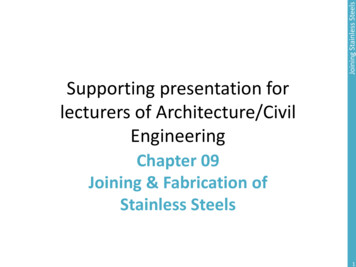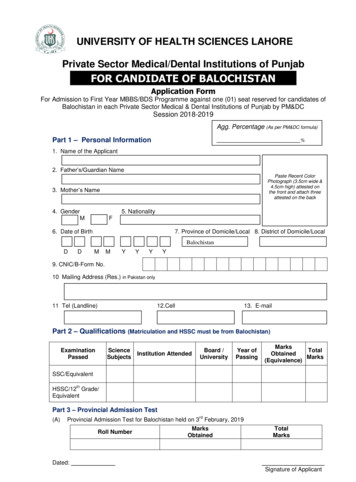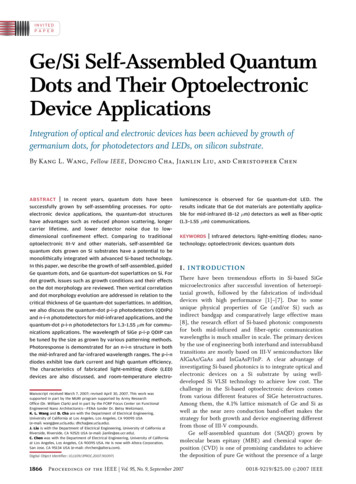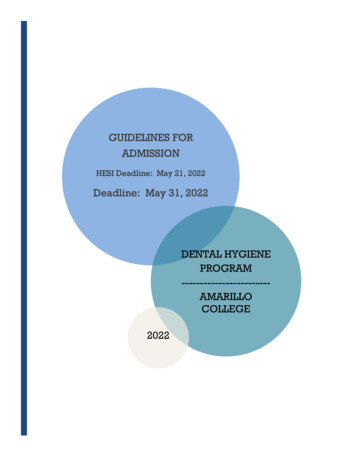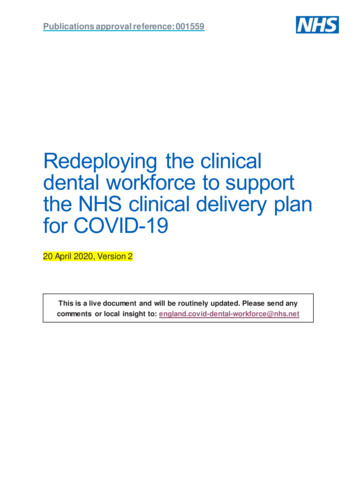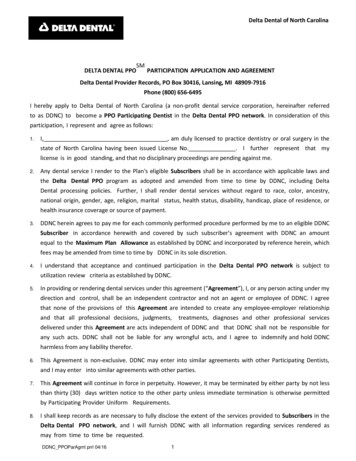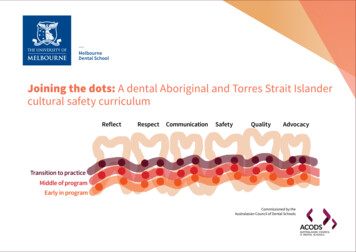
Transcription
MelbourneDental SchoolJoining the dots: A dental Aboriginal and Torres Strait Islandercultural safety AdvocacyTransition to practiceMiddle of programEarly in programCommissioned by theAustralasian Council of Dental Schools
Acknowledgement of CountryAboriginal and Torres Strait Islander peoples are the oldest continuous culture in the world. Aboriginal and Torres Strait Islander people never ceded sovereignty and we recognisethe impacts colonisation continues to have on the health of Aboriginal and Torres Strait Islander people to date. We acknowledge Aboriginal and Torres Strait Islander Peoples fortheir continuing connection to culture, language and Country; along with Elders past, present and emerging and the ancestors that walk with Aboriginal and Torres Strait Islanderpeople every day. We recognise the Aboriginal and Torres Strait Islander leadership, excellence, and spirit of partnership which helped to formulate this strategy, in our efforts toaffect systemic health reform to help close the gap in health outcomes for Aboriginal and Torres Strait Islander people.Disclosure: Language and terminologyWe acknowledge the diversity of Aboriginal and Torres Strait Islander peoples and the range of preferences for language, and that there are a range of terms used and preferredaccording to local context including Aboriginal, Aboriginal and Torres Strait Islander Peoples, First Nations, First Peoples and Indigenous Australians. We use all these termsrespectfully in this document and in reference to the various resources used in the preparation of this document. The term ‘Indigenous people’, in reference to Aboriginal and TorresStrait Islander people of Australia aligns with the United Nations use of Indigenous in the ‘Declaration on the rights of Indigenous Peoples’ and is therefore familiar to a national andglobal audience.2 Joining the dots: A dental Aboriginal and Torres Strait Islander cultural safety curriculum
JOINING THE DOTS: A DENTAL ABORIGINAL ANDTORRES STRAIT ISLANDER CULTURAL SAFETY CURRICULUMTABLE OF CONTENTSAcknowledgements4Introduction7Section 1: Literature Review10Section 2: Curriculum Structure17Section 3: The Curriculum20Section 4: Resources and Example Support Materials36Section 5: Advice on Getting Started52References57Appendix 1. Cultural Safety Definitions- AHPRA61Appendix 2. The Australian Dental Council (ADC) / Dental Council (New Zealand) (DC(NZ))Accreditation standards for dental practitioner programs as they apply to cultural safety (2021)62Appendix 3. Australian Dental Council Professional Competencies for Dental Practitioners63Melbourne Dental School, The University of Melbourne 3
ACKNOWLEDGEMENTSThe AuthorsProf Julie Satur, Director Indigenous Programs and Engagement, Melbourne Dental School, The University of MelbourneDr Cathryn Forsyth, Indigenous Cultural Competence in Dentistry and Oral Health Higher Education, University of Sydney,Advocacy and Policy Advisor Australian Dental Association NSW BranchMs Joanne Bolton, Interprofessional Education & Practice Development Fellow, Faculty Medicine, Dentistry and Health Sciences, The University of Melbournewish to acknowledge the important contribution of the Reference Group Members in shaping this curriculumMs Corinne Webster, Oral Health Therapist and proud Dharawal woman, Sydney Local Health District, NSW HealthMs Rachel Williams, Oral Health Therapist, Armajun Aboriginal Health Service, NSWMs Aisha Mansfield, Dental Assistant DHSV & BOH Student (La Trobe University) and proud Palawa-Moonbird womanDr Gari Watson, President, Indigenous Dentists Association of Australia, proud Goreng Goreng, Gangulu and Biri Gubba manMs Tracey Hearn, Manager Dental Program, Rumbalara Aboriginal Corporation and proud Yorta Yorta womanA/Prof Boe Rambaldini, Director, Poche Centre for Indigenous Health, University of Sydney proud Bundjalung manDr Delyse Leadbeatter, Director of Academic Education Senior Lecturer, School of Dentistry, University of SydneyA/Prof Louisa Remedios, Lead, Indigenous Physiotherapy Cultural Safety Curriculum, University of Melbourne,Dr Roisin Mc Grath, Director Bachelor Oral Health, Melbourne Dental School, University of MelbourneDr Rebecca Wong, Director Teaching and Learning, Melbourne Dental School University of MelbourneDr Srinivas Varanasi, Bachelor of Dental Prosthetics-Lead Dental Teacher, TAFE QldProf Robert M Love ONZM, Chair Australasian Council of Dental Schools (ACODS)Prof Ivan Darby, Director Post Graduate Programs, Melbourne Dental SchoolProf Rodrigo Marino, Melbourne Dental School (Cultural Competence Research), University of MelbourneProf Hien Ngo, Representative ACODS, Dean and Head of Dental School, University of WAMs Natasha Lethorn, Head Bachelor Oral Health Therapy Program Curtin University4 Joining the dots: A dental Aboriginal and Torres Strait Islander cultural safety curriculum
and the individuals and organisations who provided consultation and adviceMr Josh Cubillo, Indigenous Program Manager, Faculty of Medicine, Dentistry and Health Sciences, the University of MelbourneMs Urvashnee Govender, Lecturer and Program Director Bachelor of Dental Hygiene, School of Medicine and Dentistry, Griffith UniversityMs Kelly Jean Burden Associate Lecturer, Oral Health, Faculty of Medicine and Health, School of Dentistry, The University of SydneyMr Tylen Burt, Director Policy and Advocacy, Australian Dental and Oral Health Therapists AssociationMs Eithne Irvin, Deputy CEO & General Manager Policy & Advocacy, Australian Dental AssociationDr Samantha Byrne, Senior Lecturer Oral Biology, Divisional Lead Dental Education and Innovation Melbourne Dental SchoolDr Chris Bourke, Program Director, Indigenous Science and Engagement, CSIRO, CanberraDr John Skinner, Acting Research Director and Senior Research Fellow, The Poche Centre for Indigenous Health, University of SydneyDr Carol Tran and Dr Kelly Hennessy, Dept of Oral Health, Central Queensland UniversityProf Jakelin Troy, Director Indigenous Research, Office of the Deputy Vice Chancellor, The University of SydneyMelbourne Dental School, The University of Melbourne 5
ansition to practiceMiddle of programEarly in programThe image for this curriculum shows 6 teeth representing the 6 oral health focus areas (domains) of the curriculum with transitioning layers representing the development oflearning from the establishment of a base of knowledge to the transition to practice (eruption through the gingiva into functional occlusion) deepening as it develops.The 12 dots at each of the 3 levels (2 per tooth/domain) represent the individual learning outcomes, 36 in total and they are ‘joined’ by their relationships to each other bothvertically and horizontally through the lines and layers of learning.The ends of the layers of learning beyond the edge of the tooth set and beyond transition to practice demonstrate that the learning journey (like eruption and occlusion) incorporatesother experiences and is life-long, extending and continuing beyond both the structure of, and the end of the program.Image acknowledgementThe ‘joining the dots’ graphic was developed and refined using the consultation processes with the Reference Group during the project. It draws from a technique of ‘curriculumvisualisation’ as a communication tool to share key curriculum information with educators, students and program leads and was refined using the consultation processes aroundthe project.Suggested CitationSatur J, Forsyth C, Bolton J (2021) Joining the dots: A dental Aboriginal and Torres Strait Islander cultural safety curriculum, The University of Melbourne Dental School for theAustralasian Council of Dental Schools6 Joining the dots: A dental Aboriginal and Torres Strait Islander cultural safety curriculum
INTRODUCTIONCommissioned by the Australasian Council of Dental Schools, this document describes a DentalAboriginal and Torres Strait Islander Cultural Safety Curriculum to inform educational preparationof dental practitioners with reference to Standard 6.3, Australian Dental Council AccreditationStandards, 2021. (See Appendix 1 & 2).The purpose of cultural safety preparation in dental practitioners is to ensure that the health, self-determination andwell-being of Aboriginal and Torres Strait Islander peoples is enabled and supported in all interactions with healthpractitioners, and experiences of health care.Aim of the project:To develop an oral health cultural safety curriculum that focuses on Aboriginal and Torres Strait Islander oral health and addresses the Australian Dental Councilaccreditation standards ffers a model for integration of cultural safety preparation throughout the dental program and clearly articulatesorequired learning outcomesObjective of the Curriculum:The twofold purpose of this curriculum is to contribute to the development of new graduate dental practitioners withappropriate knowledge, skills and practice to provide culturally safe oral health care and, to create a culturally safeeducational approach which will support the development of an Indigenous dental workforce.This project acknowledges the work of Aboriginal and Torres Strait Islander peoples and communities in leading theprovision of better healthcare delivery, and this project builds from existing Aboriginal and Torres Strait Islander HealthCurriculum frameworks (ATSIHCF 2014) and the generosity of Indigenous academics, clinicians, service-users andstudents in the Reference Group sharing knowledges and guiding the development of this framework.Without cultural safety, there is no clinical safety and patient safety includes theinextricably linked elements of clinical and cultural safety. (AHPRA, 2021).Melbourne Dental School, The University of Melbourne 7
Definitions for this ProjectAboriginal and Torres Strait Islander peoples and communities are the oldest continuing culture in the world and have generations of wisdom and practice knowledges regardinghealth and healing. Indigenous ways of knowing, being and doing has much to offer contemporary healthcare systems, health professions education and healthcare services interms of improving effectiveness, quality, and safety.It is essential that all dental and oral health professionals in Australia are able to provide healthcare services free from racism and culturally safe for all people receiving healthcare.The term ‘cultural safety’ first developed in Maori nursing practice in the 1990’s (Papps and Ramsden, 1996) and is now part of all entry-to-practice and specialist accreditationstandards in Australia. Without cultural safety, there is no clinical safety and ‘patient safety includes the inextricably linked elements of clinical and cultural safety’ (AHPRA, 2021).Cultural safety is a component of being ‘fit to practice’ as a safe and effective health professional.While the focus of cultural safety preparation and skill development needs to be on all cultures, and all people receiving care benefit from a cultural safety practice approach, thefocus of this curriculum framework is specific to Australia’s First Peoples acknowledging the term ‘cultural safety practice’ is an Indigenous concept. This term was conceptualisedas a result of the ongoing impacts of colonisation and racism that position Australia’s First Peoples as having frequent experiences of culturally unsafe healthcare delivery, whichimpacts negatively on poorer health outcomes.There are a variety of terms in practice and in the literature including cultural safety, cultural awareness, cultural humility, cultural sensitivity, cultural competence, and culturalsecurity. For this project we use the concept of ‘cultural safety’ with specific reference to First Peoples in Australia, and we define the concept for the purpose of this curriculumframework with reference to definitions used by the Australian Health Practitioner Regulation Agency (AHPRA 2021):‘Cultural Safety is defined as the individual and institutional knowledge, skills, attitudes and competencies needed to deliver optimalhealth care for Aboriginal and Torres Strait Islander Peoples’.‘Cultural Safety is determined by Aboriginal and Torres Strait Islander individuals, families and communities.’‘Culturally safe practice is the ongoing critical reflection of health practitioner knowledge, skills, attitudes, practising behaviours andpower differentials in delivering care that is safe, accessible and responsive healthcare free from racism’(AHPRA, 2021)8 Joining the dots: A dental Aboriginal and Torres Strait Islander cultural safety curriculum
The Australian Health Practitioner Regulation Agency (AHPRA) outlines four key areas required to ensure culturally safe practice, which weconceptualise as being inter-related, shown here in Figure 1. In keeping with AHPRA’s conceptualisations, this project utilises these four inter-relatedelements to underpin the development a dental curriculum for cultural safety.Cultural safety is a spirit of practice taking into account Aboriginal and Torres Strait Islander peoples’ strong connections to Country and views ofhealth and well-being as described through the social determinants of health. Cultural safety requires oral health care professionals and organisationsto undertake an ongoing process of critical self-reflection and cultural self-awareness. It requires active steps to address identified bias, assumptions,and systemic racism. Cultural safety requires individual and institutional knowledge, skills, attitudes and competencies, to enable optimal oral healthcare for Aboriginal and Torres Strait Islander peoples, free of racism, as determined by Aboriginal and Torres Strait Islander individuals, families andcommunities.Figure 1. The Australian Health Practitioners Regulatory Agency’s four elements ofculturally safe practice (AHPRA 2020)Melbourne Dental School, The University of Melbourne 9
SECTION 1: LITERATURE REVIEWBackgroundPrior to colonisation Indigenous people lived in harmony with the land and experienced health & vitality (Martin 2003). The Indigenous concept of health is holistic, with selfdetermination being central to the provision of Indigenous health services. Indigenous research methodologies centre the Indigenous voice and facilitate distinct ways of knowing,being and doing, offering a viable basis from which to contemplate the historically, geographically, and spiritually embedded nature of Indigenous self-determination, which iscentral to the study of Indigenous knowledge (Latulippe, 2015). Indigenous social and emotional well-being comprises of seven inter-related domains; kinship or family, Country,community, culture, body, mind or emotions, and spirituality (Dudgeon, 2017). A multifaceted, holistic, strength-based approach has been employed in the development of thiscultural safety curriculum.Colonial processes and policies have resulted in dispossession, physical ill-treatment, economic exploitation, discrimination and cultural devastation of Indigenous peoples (Graceyet al 2009, Larson et al 2007). Racism is a major factor contributing to the poor health of Indigenous Australians, with interpersonal and institutional racist attitudes and behavioursbeing embedded in social, structural and political contexts contributing to the dental and oral health inequalities experienced by Indigenous people in Australia (AIHW 2019).Indigenous peoples living in Australia experience higher mortality rates and carry the greatest burden of disease in both general and oral health. Despite Australia’s Indigenous andnon-Indigenous health bodies working together to address health inequality for Indigenous people in Australia, several Close-the-Gap policies have failed to achieve significantimprovements in health outcomes. Unacceptable disparities in health and disease continue to exist, leaving Indigenous Australians disadvantaged across a range of health indicators(Vos et al 2009, Mitrou et al 2014).Oral health disparities between Indigenous and non-Indigenous Australians are significant, with 27% of Indigenous people suffering toothache compared to 15% of non-IndigenousAustralians. Edentulism among Australians born between 1950-69 is higher, with 7.6% of Indigenous people experiencing complete tooth loss compared with just 1.6% among nonIndigenous Australians of the same cohort. Indigenous Australians have the highest proportion of people with untreated dental decay; 57% compared to 25% in the non-Indigenouspopulation, while 10.9% of Indigenous Australians experience severe tooth wear compared to 3.2% of non-Indigenous Australians. In 2012, the prevalence of periodontal disease was3.5 times higher among Indigenous Australians (Kapellas et al 2014). Indigenous children have consistently higher levels of dental decay in the deciduous and permanent dentitionthan their non-Indigenous counterparts, with the most affected being those in socially disadvantaged groups and those living in rural or remote areas. Trends in Indigenous childdental decay prevalence indicate that dental decay levels are rising, particularly in the deciduous dentition (Jamieson et al 2007, Lalloo et al 2016).Dental treatment in Australia is expensive, with few Australians meeting the criteria for free public dental treatment. Australia spends over 10.2 Billion a year on dental care, withover 2 million people not receiving necessary dental care due to lack of access and expense. In 2017-18, a significant proportion of the 72,000 hospitalisations for dental conditionsmay have been prevented with adequate prevention services and access to earlier treatment (AIHW 2021, Duckett et al 2019). Aboriginal and Torres Strait islander people generallyhave poorer access to dental care and preventive services; among those who visited a dentist in 2018-2019, two thirds receive care through publicly funded services includingAboriginal Community Controlled Health Organisation (ACHHO) dental services (AIHW NIAA, 2020). There is considerable evidence of underutilisation of dental services despitehigh levels of disease being common in many communities and community norms where people are resigned to poor oral health. Institutional and individual racism, attitudes andempathy of dental staff, cultural friendliness, fear and other barriers to access for Aboriginal people are well recognised (Schluter et al 2017, Krichauf et al 2020).10 Joining the dots: A dental Aboriginal and Torres Strait Islander cultural safety curriculum
Incorporating cultural training in medicine and health servicesWhile cultural safety is the contemporary terminology used in the Australian education context, an extensive literature informs this project.The concept of ‘cultural competence’ in healthcare that emerged in the United States in the 1980s had a focus on improving the accessibility andeffectiveness of health care delivery for people from racial or ethnic minority groups. Cultural competency, the term used at this point, was defined by Crossand colleagues as those, ‘congruent behaviours, attitudes and polices that come together in a system, agency or among professionals and enable that system, agencyor those professionals to work effectively in cross cultural situations’. The goal of cultural competence according to many authors is to create educational institutions,health care systems and workforces that are proficient at delivering high quality care for all patients regardless of race, ethnicity, culture, gender, or language.Cultural competence is required at all levels, from organisational to individual, as it was recognised that clinicians will increasingly see patients from different culturalbackgrounds (Cross et al 1989, Betancourt et al 2003). Australia is a multicultural society with many culturally and linguistically diverse groups requiring provision ofculturally appropriate dental and oral health care. This project focuses on cultural competence and safety applying to Indigenous people in Australia and, while thereare many transferable skills, multicultural dental and oral health care is being addressed in other forums (Marino et al 2012, 2016, 2017).Previous efforts to increase Indigenous cultural competence within healthcare in Australia have primarily been designed for specific situations, lacking a coherentapproach to inclusion in curricula; therefore, the teaching of Indigenous cultural competence remains fragmented and inadequate (Downey et al 2011). Reducing healthdisparities and confronting the effects of racism require a multi-tiered commitment to action and the political will to eliminate race-based inequities in the healthcare system (Brondolo et al 2009, Durey 2010). Culturally competent institutions value diversity, conduct self-assessment, manage the dynamics of difference, acquirecultural knowledge, and adapt to diversity and the cultural contexts of the communities they serve. Every level of policy making, administration and service deliverymust be involved in implementing and sustaining cultural competence, including all key stakeholders and communities with which the institution is involved. Culturalcompetence is a developmental process that evolves over an extended period of time. Individuals and institutions initially have varied levels of awareness, knowledge,and skills. Successful integration of cultural competence within institutions results in positive progression along the cultural competence continuum (Goode et al 2009).Effective cultural competence requires a commitment to achieving culturally appropriate service delivery and a culturally appropriate workplace environment throughincorporation of cultural knowledge into policy, infrastructure and practice. Cultural competence embraces the principles of equal access and non-discriminatorypractices in service delivery and is achieved by identifying and understanding the needs and specific behaviours of individuals and communities. Ideally an advisoryteam should be established to steer the development, implementation and evaluation of cultural competence training within an organisation, with membershipincluding Indigenous staff and Indigenous community representatives. Stakeholders in health care, government and academia view cultural competence as animportant strategy in addressing health care disparities. Health care workers need to understand the relationship between cultural beliefs and behaviour and developskills to improve quality of care to diverse populations. Concern has been expressed about teaching strategies that promote stereotypes of particular cultures,highlighting issues that may be relatively neglected, such as empathy, socioeconomic factors, and prejudice or discrimination in the clinical encounter. Emergingregulatory and accreditation pressures, societal pressures, funding opportunities, and the increasing diversity of patients, students and academic staff are key driversof a focus on cultural competence. There is pressing need for a unified cultural safety conceptual teaching framework, as there is currently great variability in theavailability and quality of training programs and specific training for faculty members (Betancourt 2005).Cultural competence strategies aim to make health services more accessible for patients from diverse cultural backgrounds. Recent strategies have focused onspecific groups, particularly Indigenous Australians, where services have failed to address large disparities in health outcomes. Currently their development has beenhampered by a lack of clarity around how the concept of culture is used in health and the scarcity of outcomes-based research that provides evidence of the efficacy ofcultural competence strategies. A limited conceptualisation of culture often conflates culture with race and ethnicity, thereby failing to capture diversity within groups,reducing the effectiveness of cultural competence strategies and impeding the search for evidence linking cultural competence to a reduction in health disparities.Attention to cultural complexity, structural determinants of inequality and power differentials within health care settings not only provides a more comprehensivenotion of cultural competence and a refined understanding of the role of culture in the clinic but may also help to determine the contribution that cultural competencestrategies can make to a reduction in health disparities (Thackrah et al 2013).Melbourne Dental School, The University of Melbourne 11
Incorporating cultural training in medicine and health educationIn higher education, cultural safety is an educational strategy to prepare the future healthworkforce to care for diverse patient populations, with a particular focus on the developmentof a skill set for more effective patient-provider communication. There are six main modelsthrough which cultural training is conceptualised (Figure 2). In this diagram, the models arelocated according to their emphasis on individual versus systemic behavioural change andthe extent to which they include reflection on one’s own culture as a basis for understandingother cultures. Cultural awareness aims to increase awareness of cultural, social and historicalfactors relevant to Indigenous peoples, groups, communities and to promote self-reflectionon one’s own culture and tendency to stereotype. Cultural competence focuses on a set ofassociated behaviours, attitudes and policies that can prevent the negative effects thatmay arise from disregarding culture in the provision of health care services. Cultural safetyaddresses the ways in which colonial processes and structures shape and negativelyimpact health, with specific focus on the experiences of individuals seeking health care.Cultural security refers to the impact of culture on access to health services and aims to helpthe health system and its workers to incorporate culture in their delivery of services. Culturalrespect seeks to develop health services that are more accessible and to uphold the rightsof Indigenous peoples to maintain, protect and develop their culture and achieve equitablehealth outcomes. Transcultural care highlights formal areas of study and practice in thecultural beliefs, values and lifestyles of diverse cultures, with focus on power relationships,racism and the conceptualisation of identities (Downing et al 2011).Several higher education reviews have identified the need for all tertiary institutions toincorporate Indigenous culture and knowledges more widely into all curricula to improveeducational outcomes for Indigenous Australians and to increase cultural safety amongFigure 2: Comparison of theoretical models underlying Indigenous culturalall students. In 2008, the Bradley ‘Review of Australian Higher Education’ recommendedtraining (Downing et al. 2011)that higher education providers should ensure that the institutional culture, the culturalcompetence of staff and the nature of the curriculum recognise and support the participation of Indigenous students and that Indigenous knowledge should be embedded intothe curriculum so that all students gain an understanding of Indigenous culture (Bradley 2008). From 2009-2011, Universities Australia investigated existing Indigenous culturalcompetency initiatives and programs in Australian universities to establish a clear baseline for Indigenous cultural competency activities. Subsequently, a National Best PracticeFramework and Guiding Principles for Indigenous Cultural Competency in Australian Universities were developed (Universities Australia 2011). During 2012, the Behrendt Reviewof Higher Education Access and Outcomes for Aboriginal and Torres Strait Islander People, building on the Bradley Review, examined how improving higher education outcomesamong Indigenous peoples would contribute to nation building and reduce Indigenous disadvantage. In 2014 the Commonwealth Government published an enabling curriculum inAboriginal and Torres Strait Islander Health to support the incorporation of these recommendations. Arising from these developments, the Australian Health Practitioner RegulationAgency (AHPRA) and the National Boards published their Aboriginal and Torres Strait Islander Strategy:2020-2025 with the objective of establishing consistent approaches to culturalsafety across all the health practitioner groups (AHPRA 2020). Indigenous peoples in Australia are significantly under-represented in the higher education system, which contributesto the high levels of social and economic disadvantage they often experience. Additionally, encouraging Aboriginal and Torres Strait Islander graduates who are qualified to take upprofessional, academic and leadership positions within community, government and corporate sectors will help to address this disadvantage (Behrendt et al 2012, DBA 2020). The12 Joining the dots: A dental Aboriginal and Torres Strait Islander cultural safety curriculum
Australian Dental Council (ADC) accreditation standards for dental educational programs which inform this project also supports the recruitment,admission, participation, retention and completion of dental and oral health programs by Aboriginal and Torres Strait Islander Peoples along withother approaches to resolving structural inequality (ADC 2021, see Appendix 2).Indigenous Cultural Training in Education for Dental PractitionersIn 2007, a team of dental and medical academics from the University of Western Australia developed a multi-level teaching framework based ona review of graduate attributes to reflect the needs of Indigenous oral health. Two new outcomes were added to the Fundamentals of ClinicalDentistry stream, and two outcomes in the Personal and Professional Development stream were modified. Year level outcomes were devised toprovide vertical and horizontal integration into the existing curriculum, commencing with foundational knowledge and building in complexity toachieve graduate ou
Melbourne Dental School, The University of Melbourne 3 JOINING THE DOTS: A DENTAL ABORIGINAL AND . Central Queensland University Prof Jakelin Troy, Director Indigenous Research, Office of the Deputy Vice Chancellor, The University of Sydney. . The term 'cultural safety' first developed in Maori nursing practice in the 1990's (Papps .




